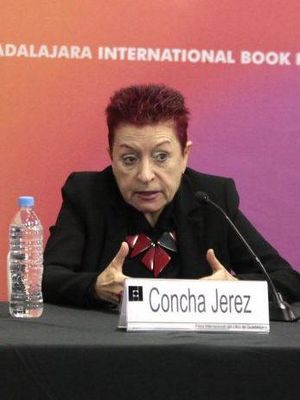Concha Jerez facts for kids
Quick facts for kids
Concha Jerez
|
|
|---|---|
 |
|
| Born | 1941 (age 83–84) Las Palmas, Spain
|
| Alma mater | Complutense University of Madrid |
| Occupation | Artist |
| Years active | 1970–present |
| Employer | University of Salamanca (1991–2011) |
| Known for | Conceptual art |
| Awards |
|
Concha Jerez (born in Las Palmas de Gran Canaria, Spain, in 1941) is a Spanish artist. She is known for being a pioneer in conceptual art. This type of art focuses on ideas and concepts rather than just the finished artwork. Her work often looks closely at how the media influences us.
Contents
Concha Jerez's Artistic Journey
Concha Jerez first studied piano at the Madrid Royal Conservatory. In 1958–1959, she received a scholarship. This allowed her to study at Washington-Lee High School in Arlington, Virginia, USA. There, she became very interested in political and social topics. This led her to study political science at the Complutense University of Madrid.
In 1970, Concha decided to become a visual artist. She held her first art exhibition in 1973.
Exploring Media and Freedom in Art
When Concha started her career, Spain had strict rules about what people could say or show. This was known as censorship. Because of this, her art often explores ideas about media, censorship, and even self-censorship. Self-censorship is when someone holds back their own thoughts or expressions.
In 1976, she created her first large installation called Autocensura. An installation is a type of art that uses a space to create an experience. This early work used only printed paper. In 1983, she showed another installation, Retorno al comienzo, at the Museo Vostell Malpartida.
Later, Concha began using new technologies in her art. She used video, interactive installations, photographs, and pure audio installations.
When I started in 1970, during the Franco era, the issue of self-censorship was very real. Even after democracy began, I saw that it continued, not just in public life but also in private. Public self-censorship has unfortunately grown over the years, adding things like work-related pressures. I still use these ideas in my art to show people that self-censorship exists.
Since then, Jerez has focused on performance art. This is art where the artist performs actions for an audience. She also develops installations that are created specifically for large spaces. Many of her works combine different art forms. She is known as one of Spain's first conceptual artists.
Using New Technologies in Art
Concha started making video art in the early 1980s. Her first video installation was about a staircase. It was shown at the First International Video Festival of Madrid in 1984. Later, she was invited to create an installation at the First Media Art Festival in Osnabrück, Germany.
Jerez has also created radio art pieces for different radio stations in Europe.
Since 1976, she has worked on many projects with composer and artist José Iges. In 2015, they presented Media Mutaciones in Madrid. This exhibition showed their joint projects, including works from the 1970s and their current visual and sound art.
From July 2014 to January 2015, the Museo de Arte Contemporáneo de Castilla y León showed her exhibition Interferencias en los medios.
Teaching and Advocacy
In 2015, Concha Jerez received the National Award for Plastic Arts. She won this award for being a pioneer in using technology in art. The award recognized her as an artist who helped bridge the gap from older art forms to digital art.
Jerez was also a teacher at the University of Salamanca's Faculty of Fine Arts. She taught there from 1991 to 2011.
Her art and her actions often show her support for Feminism and left-wing ideas.
Of course, I have to be a feminist when I see the situation of women. There are so many people affected by gender violence, unequal pay, and it's hard for women to get important political or private jobs. We must fight against these problems and teach from a young age, starting in school, to value how capable women are in economic, political, and social areas.
Jerez has helped organize and has been an active member of various groups for women and artists. This includes the Asociación de Mujeres en las Artes Visuales (MAV). This association gave her an award in 2012 to recognize her long career.
In 2018, she took part in an exhibition called La NO comunidad at the CentroCentro. Her work, Soliloquios cotidianos, explored the idea of loneliness in the modern world.
Also in 2018, for the 40th anniversary of the Constitution of Spain, her installation Textos autocensurados.Versión 1,1976 was chosen for an exhibition. This exhibition, El poder del arte, was shown for the first time in the buildings of the Congress of Deputies and the Senate.
Awards and Recognitions
Concha Jerez has received many important awards for her art:
- 2011: Gold Medal of Merit in the Fine Arts
- 2012: Asociación de Mujeres en las Artes Visuales Award
- 2015: National Award for Plastic Arts
- 2017: Velázquez Award for Plastic Arts
- 2018: Gold Medal of the Canary Islands
See also
 In Spanish: Concha Jerez para niños
In Spanish: Concha Jerez para niños

